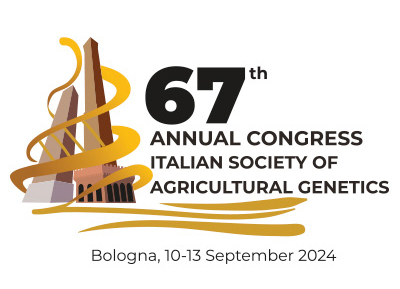POSTER COMMUNICATIONS
5.10
Improving Fusarium verticillioides resistance in maize through a LOX gene overexpression
Ottaviani L., Widiez T., Marocco A., Lanubile A.
5.11
Exploring the role of a WRKY gene by CRISPR/Cas editing to enhance pathogen resistance in maize
Ottaviani L., Widiez T., Marocco A., Lanubile A.
5.12
The first high chromosome scale genome of cultivated cardoon for deciphering the molecular basis of bioactive compounds production
Gaccione L., Vergnano E., Martina M., Lanteri S., Elia A., Conversa G., Mauromicale G., Lombardo S., Barchi L.
5.13
Sustainable use of bioactive compounds from Solanum tuberosum L. peel waste for cereal crop protection
Pacifico D., Lanzanova C., Righetti L., Bassolino L., Nicoletti F., Bianchi G., Parisi B., Calzone A., Lo Scalzo R.
5.14
Safeguarding tomato crops: Developing varieties resistant to Tomato Brown Rugose Fruit Virus (ToBRFV)
Mariani A., Bocchini M., Marconi G., Schiappa A., Manilia G., Albertini E.
5.15
Integrated approach to discover new sources of scab resistance in apple
Baldi P., Nicolussi Golo G., Malnoy M.
5.16
Mapping fusarium ear rot resistance using recombinant hybrids developed from the MAGIC maize population
Stagnati L., Caproni L., Neupane S.P., Busconi M., Lanubile A., Pè M.E., Dell’Acqua M., Marocco A.
5.17
Susceptibility Genes: the new frontier for enhancing tolerance to pathogens in chestnut
Pavese V., Marino L.A., Ferrero M., Milani A.M., Corredoira E., Martínez M.T., Sabbadini S., Capriotti L., Mezzetti B., Lione G., Gonthier P., Torello M.D., Botta R., Moglia A.
5.18
Transcriptional re-wiring within a plant-endophyte-parasite system
Curci P.L., Lee J.M., Tan Q.W., Mutwil M., Ciancio A., Finetti-Sialer M.
5.19
Transcriptional and phenolic profiles of fungus-resistant grapevine cultivars and their implications for winemaking
Smimmo R., Gallucci A., Napolitano F., Frusciante L., Picariello L., Gambuti A., Forino M., Aversano R., Villano C.
5.20
Molecular characterization of putative olive genotypes resistant to Xylella fastidiosa in South Apulia
de Pinto R., Carlucci M., Savoia A.M., Lucchese P.G., Aurelio F.L., Miazzi M.M., Montemurro C., Nigro F.
5.21
Improving grapevine resilience against biotic stresses exploiting genome editing approaches: from MLO to NPR genes
Nerva L., Moffa L., Narduzzo A., Bevilacqua I., Perrone I., Pagliarani C., Gambino G., Velasco R., Chitarra W.
5.22
Understanding the Pseudopyrenochaeta lycopersici-tomato interaction by CRISPR-Cas9
Aragona M., Milc J.A., Infantino A., Festa G., Cuccurullo A., Nicolia A.
5.23
A genome-wide analysis of transposable elements and resistance genes in cucurbits
Mascagni F., Usai G., Auzino B., Castellacci M., Rogo U., Natali L., Ercolano M.R., Cavallini A., Andolfo G.
5.24
QTL mapping and candidate gene identification for powdery mildew resistance in durum wheat
De Cicco R., Nigro D., Piarulli L., Signorile M.A., Mangini G., Simeone R., Blanco A.
5.25
Investigating the effects of Xylella fastidiosa infection on four olive cultivars through comparative transcriptome analysis
Montemurro C., Fanelli V., Miazzi M.M., Procino S., Savoia M., Mascio I., Fruggiero C., Cafferati Beltrame L., Volpicella M., Aurelio L., Susca L., Montilon V., Taranto F., D’Agostino N.
5.26
The combination of RNAseq and WGCNA reveals the plant – biocontrol agent (BCA) interaction at molecular level in Citrus limon affected by mal secco disease
Sicilia A., Dimaria G., Russo R., Catara V., Russo M., Scialò E., Lo Piero A.R.
5.27
Plant regeneration via somatic embryogenesis and application of the DNA-free genome editing in grapevine cv. Corvina veronese and Garganega
Ciffolillo C., Bertini E., Tornielli G.B., Zenoni S.
5.28
In vitro regeneration of grapevine cv. Aglianico via somatic embryogenesis for genome editing applications
Carratore C., Bertini E., Villano C., Aversano R., Pezzotti M., Zenoni S.
5.29
Unraveling powdery mildew resistance in Cucurbita pepo: a transcriptomic and genomic exploration of two contrasting cultivars
Dublino R., D’Esposito D., Guadagno A., Capuozzo C., Formisano G., Ercolano M.R.
5.30
Loci relevant for yellow rust resistance in durum wheat adapted to the Mediterranean environments identified in cultivated and landrace germplasm through genome-wide association study
Liu C., De Sario F., Farooq M.A., Novi J.B., Viviani A., Confortini A., Carini E., Bozzoli M., Forestan C., Stefanelli S., Mazzucotelli E., Desiderio F., Mastrangelo A.M., Marone D., Viola P., Invernizzi C., El Amil R., Kumarse N., Hozkan H., Bashour I., Ragab M.E.S., Omar I., Roncallo P., Pourkhorshid Z., Bassi F.M., Cattivelli L., Tuberosa R., Gadaleta A., Maccaferri M.
5.31
AGRIVITA – Protecting Italian citrus groves from the tracheomycotic fungus Plenodomus tracheiphilus
Di Silvestro S., Aragona M., Roversi P.F.
5.32
A virus-based CRISPR/Cas9 system to increase diseases resistance in wheat
Viviani A., Camerlengo F., Tassinari A., Gualtieri R., Calzini L., Salvi S., Tuberosa R., Maccaferri M.
5.33
New breeding frontiers: application of the CRISPR-cas9 system in grapevine (V. vinifera L.) and improvements in plant regeneration
Zattoni S., Bertini E., D’Inca E., Salvalaio M., Sena G., Zenoni S.
